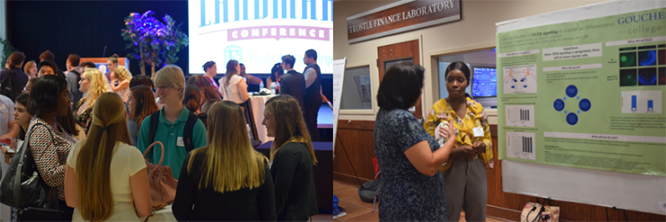Location
Presentations Session 2 - Hoover 212
Department
Chemistry and Biochemistry
Start Date
11-7-2019 2:45 PM
End Date
11-7-2019 3:45 PM
Description
A current theme in our research laboratory is the development of low cost methods for the synthesis of lamellar vesicles as models for cell membranes. These vesicles, serving as simplified artificial cells, allow us to examine fundamental properties of the membrane including transport of materials across the membrane. Vesicles of varying size can also be employed as molecule delivery systems for a variety of compounds, including pharmaceuticals. We are especially interested in pharmaceuticals used in photodynamic therapy. This type of medical intervention entails delivery of a prodrug (one which is not initially bio-active). Upon exposure to a specific wavelength of light this prodrug molecule, a photosensitizer, becomes biologically active and elicits a desired biochemical response. Various derivations of the porphyrin class of molecules have been investigated as potential photodynamic molecules. Currently, Photofrin-II, a mixture of polymerized porphyrin molecules is the only FDA-approved porphyrin-based photodynamic therapy. This particular project will merge the synthesis of non-polymerized substituted porphyrins with their integration into lamellar vesicles of varying size. In keeping with our low-cost approach to vesicle formation, we will compare the use of water-in-oil emulsion versus extrusion mode of synthesis for vesicle construction. Of interest is our ability to tailor placement of the porphyrin into the center of the lamellar vesicle, or integrated within the membrane portion of the vesicle. Though outside the scope of the current project, an important question we wish to address is: does placement of a porphyrin photodynamic compound within a lipid or aqueous environment affect its ability to function as an effective photosensitizer. The work submitted under this proposal will bring us closer to conducting experiments which will probe this question.
Recommended Citation
Schnee, Christina, "Exploring the Synthesis of Substituted Porphyrins" (2019). Landmark Conference Summer Research Symposium. 11.
https://jayscholar.etown.edu/landmark/2019/july11/11
Exploring the Synthesis of Substituted Porphyrins
Presentations Session 2 - Hoover 212
A current theme in our research laboratory is the development of low cost methods for the synthesis of lamellar vesicles as models for cell membranes. These vesicles, serving as simplified artificial cells, allow us to examine fundamental properties of the membrane including transport of materials across the membrane. Vesicles of varying size can also be employed as molecule delivery systems for a variety of compounds, including pharmaceuticals. We are especially interested in pharmaceuticals used in photodynamic therapy. This type of medical intervention entails delivery of a prodrug (one which is not initially bio-active). Upon exposure to a specific wavelength of light this prodrug molecule, a photosensitizer, becomes biologically active and elicits a desired biochemical response. Various derivations of the porphyrin class of molecules have been investigated as potential photodynamic molecules. Currently, Photofrin-II, a mixture of polymerized porphyrin molecules is the only FDA-approved porphyrin-based photodynamic therapy. This particular project will merge the synthesis of non-polymerized substituted porphyrins with their integration into lamellar vesicles of varying size. In keeping with our low-cost approach to vesicle formation, we will compare the use of water-in-oil emulsion versus extrusion mode of synthesis for vesicle construction. Of interest is our ability to tailor placement of the porphyrin into the center of the lamellar vesicle, or integrated within the membrane portion of the vesicle. Though outside the scope of the current project, an important question we wish to address is: does placement of a porphyrin photodynamic compound within a lipid or aqueous environment affect its ability to function as an effective photosensitizer. The work submitted under this proposal will bring us closer to conducting experiments which will probe this question.




Comments
Faculty mentor: Thomas Hagan, Elizabethtown College.